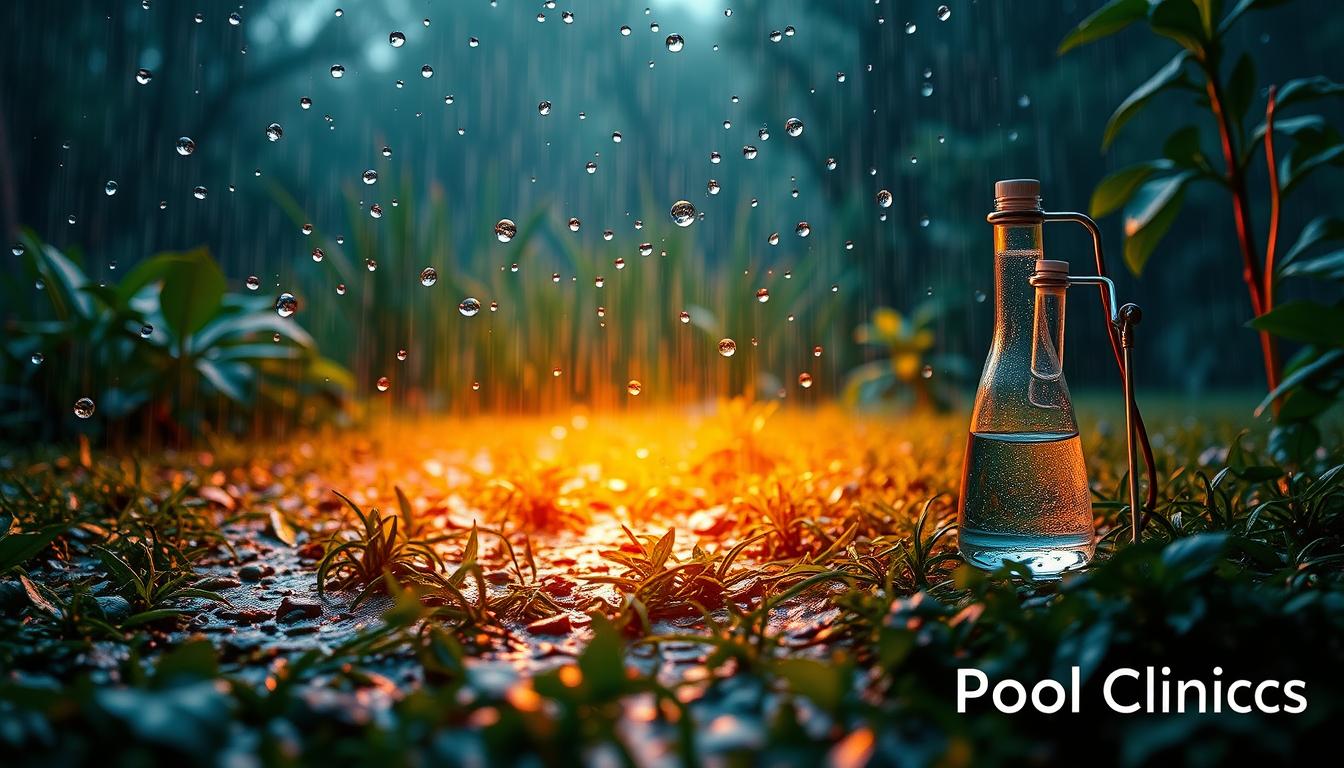
Rainstorms can wreak havoc on your pool’s water chemistry. They leave behind murky water and floating debris. The main concern is how rain affects the pH levels of your pool water.
Does rain raise or lower the pH? How does this impact your pool’s health and your enjoyment?
Rainwater pH levels vary based on local environmental factors. Usually, rainwater has a pH between 5.0 and 5.5, making it slightly acidic. This acidic water can disrupt your pool’s delicate chemical balance.
Acid rain can cause even more significant pH fluctuations. Proper pool maintenance after heavy rainfall is vital. Test pH, chlorine, and alkalinity levels, then make necessary adjustments.
A shock treatment may be needed to prevent algae and bacteria growth. These organisms thrive in the conditions created by rainwater.
We’ll explore the science behind rainwater’s acidity and its effects on pool chemistry. You’ll learn how to protect your pool investment and ensure safe, enjoyable swimming all season.
Key Takeaways:
- Rainwater is naturally acidic, with a typical pH level between 5.0 and 5.5.
- Acidic rainwater can alter the chemical balance of pool water, leading to fluctuations in pH levels.
- Proper pool maintenance after rainfall is essential to restore optimal water chemistry.
- Testing pH, chlorine, and alkalinity levels and making necessary adjustments are crucial steps post-rainfall.
- Shock treatments may be needed to prevent algae and bacteria growth caused by the influx of rainwater.
The Science Behind Rainwater’s Acidity
Rainwater becomes slightly acidic as it falls through the atmosphere. It interacts with carbon dioxide, forming carbonic acid. The average pH of rainwater is about 5.6, ranging from 5 to 5.8.
Industrial pollution and environmental contaminants can increase rainwater’s acidity. This results in acid rain, which is more harmful to the environment.

Natural Acidity of Rainwater
Water droplets react with atmospheric carbon dioxide to form carbonic acid. This weak acid lowers rainwater’s pH. Plants adapted to local pH levels may not be harmed.
However, this natural acidity can affect the pH balance of water bodies. Swimming pools are also impacted by this change in pH.
Normal rain has a pH of about 5.6 due to reacting with carbon dioxide in the atmosphere, forming mildly acidic carbonic acid.
Factors Contributing to Rainwater’s pH Levels
Industrial pollution releases nitrogen oxides and sulfur dioxide into the air. These compounds can form acid rain. Acid rain typically has a pH of 5.0 or less.
The pH of acid rain ranges from 4.3 to 5.0. This is similar to the acidity of orange juice and black coffee.
| Type of Water | pH Range |
|---|---|
| Normal Rainwater | 5.0 – 5.8 |
| Acid Rain | 4.3 – 5.0 |
| Tap Water (Hard Water Regions) | Around 8.0 |
The pH scale is logarithmic. A change from pH 5 to 4 means acidity increases tenfold. Small pH changes can greatly affect the environment and water chemistry.
Rainwater pH levels vary geographically. Lower pH is common in the eastern and northeastern United States. This is due to higher industrial pollution and acid rain.
Understanding rainwater acidity is crucial for pool maintenance. It helps in managing water chemistry and countering acid rain’s effects. Monitoring pH levels helps preserve our water resources’ delicate balance.
How Rain Impacts Pool Water Chemistry
Rain can greatly affect pool water chemistry. It dilutes pool chemicals and changes the pH balance. This impacts chlorine’s ability to keep the pool clean and safe.
Rainwater mixes with pool water, lowering chemical levels. Heavy rainfall can significantly reduce sanitizer concentrations. This makes the pool less effective at killing germs.
Dilution of Pool Chemicals
Rain dilutes essential pool chemicals like chlorine. This effect is stronger during heavy or long-lasting rainfall. As a result, the water may become less safe for swimming.
Altered pH Balance
Rainwater is naturally acidic, with a pH between 6.2 and 4.3. When it enters the pool, it can lower the overall pH level. The ideal pH for pools is 7.2 to 7.6.
Low pH can cause problems for pools. It can corrode equipment and irritate swimmers’ skin and eyes. It also makes chlorine less effective at killing germs.
| pH Range | Effect on Pool Water |
|---|---|
| Below 7.2 | Corrosive to pool equipment, irritating to swimmers, reduced chlorine effectiveness |
| 7.2 to 7.6 | Ideal range for pool water chemistry |
| Above 7.6 | Reduced chlorine effectiveness, potential for scale formation |
Effects on Chlorine Effectiveness
Chlorine is the main chemical used to clean pool water. Its effectiveness depends on the pool’s pH level. When rain lowers the pH, chlorine becomes less effective.
This can lead to the growth of harmful germs. As a result, the pool water may become unsafe for swimming.
According to the Centers for Disease Control and Prevention (CDC), maintaining proper chlorine levels and pH balance is crucial for preventing the spread of recreational water illnesses.
To counter rain’s effects, test and adjust chemical levels regularly. After rain, check pH and chlorine levels. Add chemicals to restore balance.
Sometimes, you may need to shock the pool. This eliminates contaminants from rainwater and ensures safe swimming.
Does Rain Water Raise or Lower pH?
Rainwater affects pool pH levels due to its acidic nature. It can cause short-term changes and long-term effects on pool water balance. Monitoring these changes helps maintain a safe and enjoyable swimming environment.
Short-Term pH Fluctuations Caused by Rain
After a rainstorm, pool pH levels may drop suddenly. Rainwater’s pH ranges from 6.2 to 4.3, making it slightly to moderately acidic. When mixed with pool water, it can decrease the overall pH level.
The pH drop depends on rainfall amount, pool size, and current chemical balance. To fix this, add a pH-increasing product to reach the ideal range of 7.2 to 7.6.
Long-Term Effects on Pool Water pH
Repeated exposure to acidic rainwater can cause persistent pH imbalances. This is common in areas with heavy rainfall or frequent storms. Rainwater dilutes pool water, gradually lowering alkalinity levels.
Long-term effects include corrosion of metal parts and etching of pool surfaces. It can also create an uncomfortable swimming environment. Regular water testing and chemical adjustments are necessary to maintain proper pH levels.
Proactive maintenance protects your pool investment and ensures a safe, healthy swimming experience. Address imbalances caused by rainwater promptly to keep your pool in top condition.







